
by Sandra Gulland | May 21, 2018 | Adventures of a Writing Life, Audible Editions, Promotion, The Game of Hope, Young Adult Literature |
I’m writing this in Toronto, a long way from home. Tomorrow I have a full schedule of two interviews, a book store signing, and then, in the evening, a book launch of The Game of Hope.
I sent off the final corrections to The Game of Hope last October, and since then I’ve been researching and outlining my next YA novel about a young falconer in Elizabethan England. There are no raptors in The Game of Hope, so I thought it time to reacquaint myself fully with Hortense’s world before having to answer questions about it.

Fortunately, I was able to download the audio edition of The Game of Hope this morning, and on the long drive down to Toronto today, I listened to it. And was charmed! Say hey! I think it’s quite a good story, and the narration by Janick Hebert is simply delightful.
Canadians can now get the audio edition of The Game of Hope on Audible, Kobo, Google Play or on Overdrive through your public library. On June 23, it will be available in the US.
I sincerely recommend it!
Anyone else out there still warmed by the glow of Harry and Megan? I have been!
This is my favorite photo of the pair in the open carriage. (It was snapped by Yui Mok, a photographer based in the UK, as their carriage went under an overpass.)
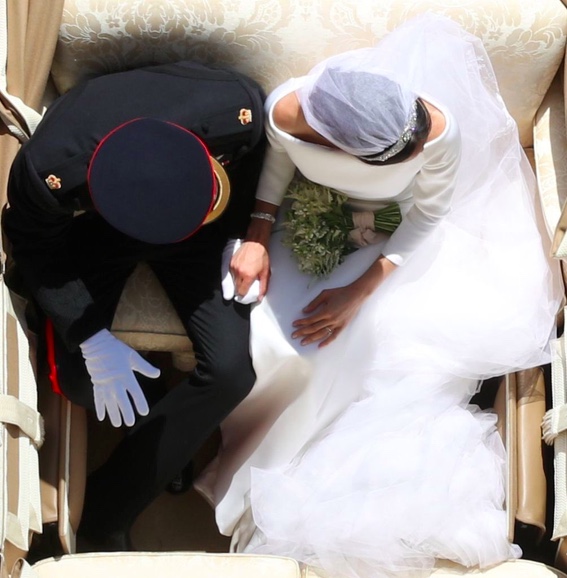
I initially intended to write this blog about an interesting article about writing historical fiction. However, “The Tourist, the Expat and the Native: A Traveler’s Approach to Crafting Historical Fiction,” by Mary Volmer deserves more than a passing reference. More on that anon…
For now, Hortense is about to meet the man she loves, and — frankly! — I’m curious to hear what happens!
Toronto photo by Sidra Saeed on Unsplash.
SaveSave
SaveSave
SaveSave
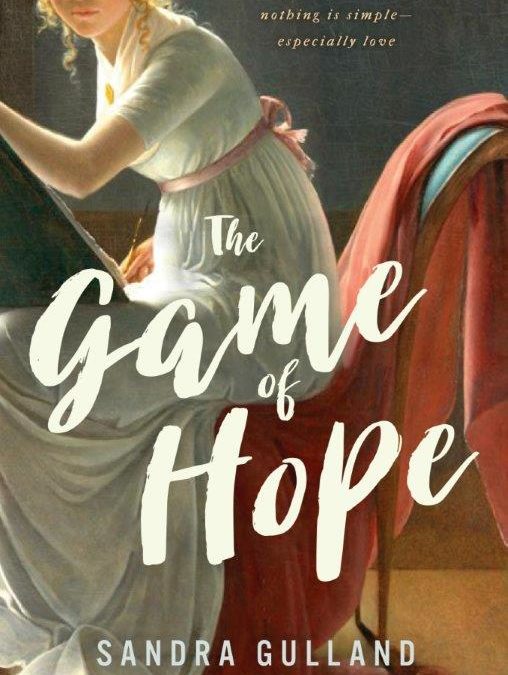
by Sandra Gulland | Apr 15, 2018 | Adventures of a Writing Life, On Plot, On Research, Publication, The Game of Hope, The Shadow Queen, The Writing Process, Young Adult Literature |
On November 2, 2011 (the day before my birthday), my agent, Jackie Kaiser, called to tell me that I’d been made a very tempting offer by Penguin to write two YA novels. One was to be about Josephine’s daughter Hortense, and the second was to be of my choosing.
My husband and I were in Mexico at the time, and two nights before I’d told him that I would never again contract to write a book “in advance.” I simply found it too stressful.
So the timing was a bit ironic. After Jackie’s call, I told my husband, “I’ve just been made an offer I can’t refuse.” Jackie had emailed me a photo of the box the offer had arrived in. Inside were the contract details and chocolates. How charming was that?

Even so, I thought about it carefully for two months. It takes me years (and years!) to write a novel, and I have to feel passionate about it. I have to fall in love with it. So I reread books about Hortense and covered our dining room table with plot points on index cards, considering. I needed to see if there was a story there, an enchanting story about Hortense’s teen years.
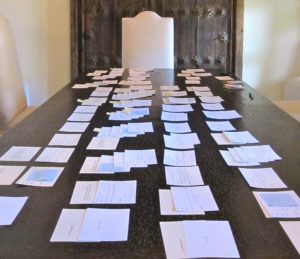
And there was. And it was one I very much wanted to write. By February 9, 2012, I had made up my mind. I would accept the offer. I would write a Young Adult novel about Hortense …
… although not immediately. I was on draft 6.1 of what I was then calling This Bright Darkness, soon to become The Shadow Queen. Plus, as I noted in that blog post of Feb. 9:
Somehow, I feel that I can do all of this all at once: finish This Bright Darkness, begin another adult novel set in the 17th century, write two YAs and a short novel for GoodReads, as well as launch my own e-book imprint.
(Reality has never been my strong suit.)
The Shadow Queen was published and my e-book imprint launched, but the “other adult novel set in the 17th century” had to be put on the back burner and the short novel for GoodReads was regretfully abandoned. Writing a novel requires full attention.

Soon I was carting research books on Hortense back and forth from Mexico to Canada.

I organized my plot cards, shuffled and re-shuffled them.
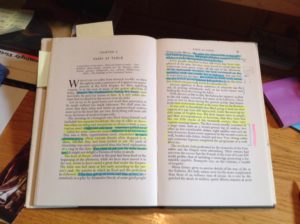
I researched like crazy.
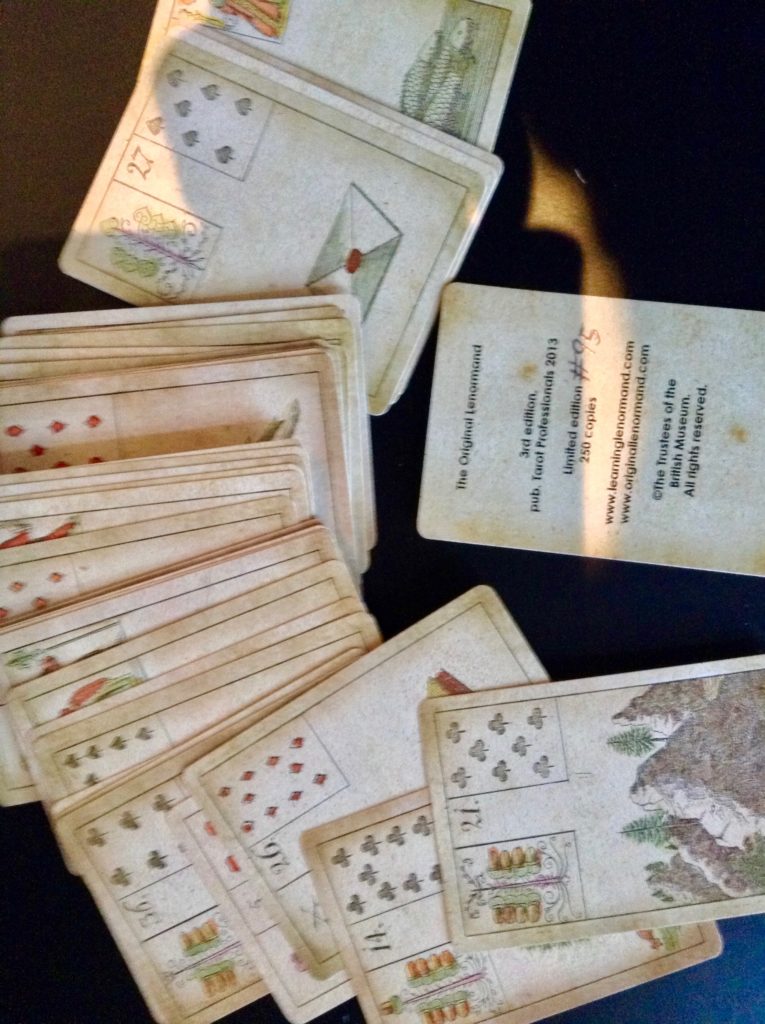
I bought a deck of The Game of Hope and began exploring. (Fun!)
On November 2, 2013, a full two years after receiving the offer from Penguin, I began the first draft.

This is draft 1.7 — that is, the 7th draft of the 1st draft.
Over the next four years, I made two research trips to France.
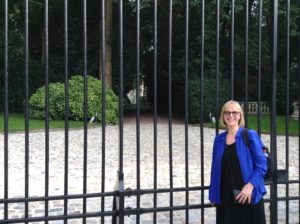
Here I am at the gates to Mortefontaine, the country estate of Napoleon’s brother Joseph.
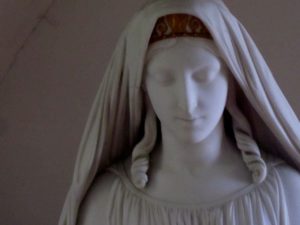
This is a statue of Hortense at her home of exile in Arenenberg, Switzerland, overlooking Lake Constance, now a delightful museum devoted to her memory.
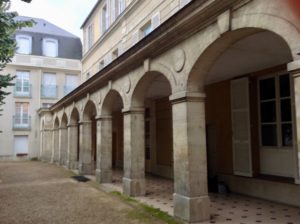
This is a photo of what remains of Madame Campan’s wonderful school in Saint-Germain-en-Laye.
Over time, I had the requisite stack of nine drafts it takes me to write a book.

During the four years it took to write The Game of Hope, it went from being a novel told in the present tense to (at a fairly late stage) a novel told in the past tense. The title changed many, many times, and settled, finally, and happily, on The Game of Hope. The cover changed many times as well.

The Game of Hope, Hortense’s story, is now a book. For real. I’ve yet to hold it in my hands, but I will soon, in Toronto on May 1, the official Canadian publication day.
The amazement I feel about this long and magical process never grows old.
SaveSave

by Sandra Gulland | Apr 1, 2018 | Adventures of a Writing Life, Podcasts, Promotion, Resources for Writers, Young Adult Literature |
I’ve become very fond of a podcast about Young Adult lit called Kidlit Drink Night. They always make me laugh and I end up making lots of notes about books, movies and TV series to look into. They call themselves “Superfriends,” which is sweet. There is a lot of laughing. They share a love of YA Lit, and an often bizarre drink for the night, which is not always met with approval. :-) They end their once-a-month sessions with the question, “What are you crushing on?” I love that.
So: What am I crushing on right now? (Other than the Kidlit Drink Night podcast.)
So: what are you crushing on?

by Sandra Gulland | Apr 1, 2018 | Mistress of the Sun, Questions Readers Ask, The Game of Hope, The Shadow Queen, The Writing Process |
Readers often ask, “What’s next?” The answer to that question depends on when the question is asked, of course. What follows is an evolving diary, begun many, many years ago.
A reader wrote some time ago:
Are you going to write more stories about the court of the Sun King?
Yes!
You did such a great job with the historical details and as I have studied Louis XIV and his court— there are plenty of interesting stories to tell (including the adventures of the Princess Palatine, even La Grande Mademoiselle and Lauzun, a couple that united even after a prison term and old age only to break up over greed).
Indeed! By the way, I love La Grande Mademoiselle, but have yet figured out how to tell her story.
You could even do a trilogy of Louis XIV’s Mistresses— you’ve done La Vallière, next could be Montespan, then Maintenon (the king’s mistress, then second wife).
I believe she’s onto me.
Or a novel on Princess Henrietta as she has a tragic back story with her father being killed, her brothers Charles and James, and she had several romances during her marriage to her cousin Monsieur that are interesting reading, including one lover who was her husband’s boyfriend who falls for Henrietta and became a master of disguise to see her at any cost (De Guiche–who visited her as a fortune teller, a litter bearer and in a domino so he could romance her in Philippe’s presence at a masked ball).
What wonderful suggestions these are. Henriette would indeed be a fantastic subject.
I especially love the De Guiche stories, and in fact wrote many scenes of him hiding in the fireplace and disguised as a fortune-teller, etc., but these scenes, like many, many others, now reside in my cut file.
What I wrote in answer to this letter above:
I am considering writing a novel about Athénaïs (Montespan), but it might focus on her first engagement more than her relationship to the king. I’m not sure. It could also be a story told from the point-of-view of Des Oeillets, her maid who was the go-between between Athénaïs and Voisin, the convicted poisoner.
As this reader points out, there are a wealth of wonderful stories to be told. The hard part is choosing. It took me eight years to write Mistress of the Sun because I kept changing perspectives. I even included the unforgettable Mademoiselle at one point.
I did, in fact, eventually choose to tell the story of The Shadow Queen from the point of view of Des Oeillets (Claudette).
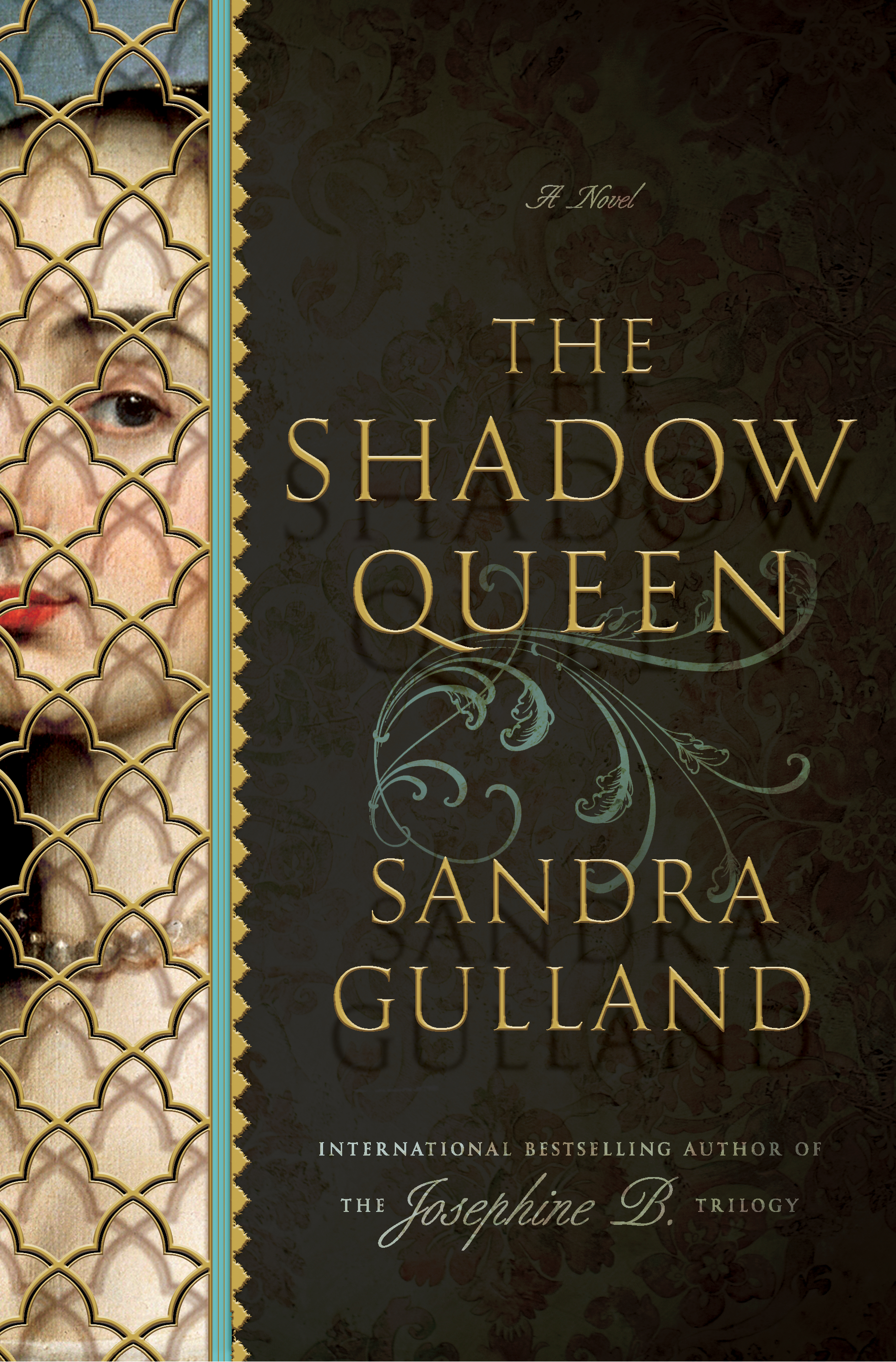
But to answer, “What’s next?” I am writing a Young Adult novel based on the teen years of Josephine’s daughter Hortense. I am back in the Napoleonic world!
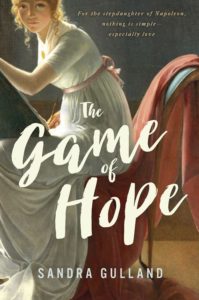
It’s Easter 2018, and Hortense’s story, The Game of Hope, will soon be published in Canada, two months later in the U.S.
As for what’s next? I’m writing — or, at least I think I’m writing — a novel about a teen, a girl falconer in Elizabethan England.
That story about Mademoiselle at the Court of the Sun King continues to haunt me, however. Might that be next next?
{Photo at top is by Evan Dennis on Unsplash.}SaveSave
SaveSave
SaveSave
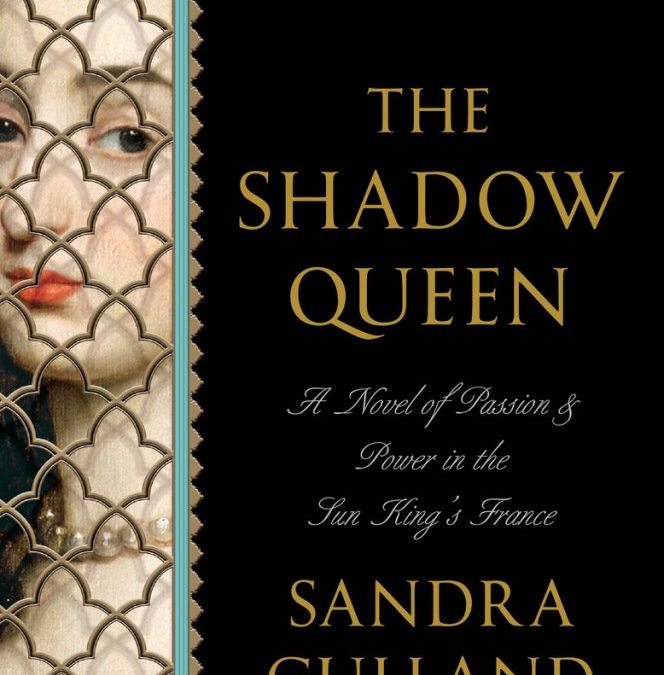
by Sandra Gulland | Mar 30, 2018 | Publication, Questions Readers Ask, Resources for Book Clubs, Resources for Readers, The Shadow Queen |
A significant number of early reviewers of my new novel THE SHADOW QUEEN have expressed displeasure with the title; they feel it is misleading. They expected the novel to be the story of the Sun King’s official mistress, Athénaïs, Madame de Montespan, a position often referred to as “the shadow queen.” The title led readers to believe that they were going to get one story, when in fact they got another. I apologize if they feel that they were mislead.
These readers were responding to the Advance Readers’ Copies (“ARCs”) of the novel. The hardcover, with cover-flap copy, will make it clearer what, in fact, the story is about, and I hope that this will dispel some of the confusion.
Why that title?
But to address the concerns of some of my readers: Why have I titled this novel The Shadow Queen?
The main character of the novel is Claude des Oeillets (dit Claudette), an impoverished young woman from the world of the theatre. Socially scorned and denounced by the church, she lives on the fringes of society. As well, as the daughter of a theatrical star, she exists in her mother’s shadow.
In contrast, Athénaïs, Madame de Montespan, lives at the heart of high society. She becomes Claudette’s obsessive passion, seeing in her a perfect life, a life without hunger and fear, a life of ease and beauty. Everything Claudette’s life is not.
The novel is about many things, but at its core is the relationship between these two woman, Claudette and Athénaïs, who are close in age and share many of the same interests, yet are worlds apart. In the end, they become dependent upon one-another. Claudette, as Athénaïs’s devoted and even start-struck servant, is willing to do anything for her—up to a point.
And it’s at that point that Claudette must step out of the shadows—and into the light of her own life.
Over the five years I was writing this novel, I considered many, many titles. In the end, I was very happy with the title The Shadow Queen, a title enthusiastically embraced by a group of 50 writers, a number of whom had read the novel and felt that it was appropriate.
I am touched by the passionate concern of my readers, even when critical. Of course I have been both surprised and disquieted that some have objected. I personally feel that the title The Shadow Queen captures the spirit of this story on a number of levels. Claudette exists in the shadow of her mother, a drama queen. When she joins Athénäis at court, she becomes her shadow, the shadow of the official “Shadow Queen.” And, although the story is very much about the ever-fascinating Athénäis—as well as about Claudette’s obsession with her and all that she represents—it’s really a metaphorical title, more than a literal one.

by Sandra Gulland | Mar 30, 2018 | On Research, The Game of Hope |
This bibliography is the list of books and magazine articles I consulted in writing The Game of Hope. Some of them I consumed, others I simply scanned, looking for one particular fact. There are a number I’ve not listed — the annotated works of Jane Austen, for example, a number of which I consumed. Also, please note that I am not an academic, and have not used correct bibliographic style. Should you wish any further information about any of these references, please contact me.
- —. De la naissance à la glorie: Louis XIV a Saint-Germain, 1638-1682. Musée des Antiquités Nationales; Saint-Germain-en-Laye; 1988.
- — . A Guide to the Wrightman Galleries. The Metropolitan Museum of Art; NY; 1979.
- — . Decorum; A Practical Treatise on Etiquette & Dress of the Best American Society 1879. Westvaco; 1979.
- — . Eugène de Beauharnais; honneur & fidélité.
- — . The Gentlemen’s Book of Etiquette and Manual of Politeness. Hesperus Press Ltd.; London; 2014 (but first published in 1860).
- — . The reign of terror: a collection of authentic narratives of the horrors committed by the revolutionary government of France under Marat and Robespierre, Volume 1. W. Simpkin and R. Marshall; place; January 1, 1826.
- —. Joséphine et Napoléon; L’Hôtel de la Rue de la Victoire. Musée national des châteaux de Malmaison et Bois-Préau; Paris; 2013.
- —. La Reine Hortense; Une femme artiste. Malmaison; Paris?; May 27 – September 27 1993. —. Lucien Bonaparte et Ses Mémoires, 1775-1840. G. Charpentier; Paris; 1882.
- —. Madame Campan (1752 – 1822). Château de Malmaison; Rueil-Malmaison; 1972. Catalog of an exhibition.
- Abbott, John S. C. Hortense.
- Al-Jabarti. Napoleon in Egypt. Translated by Shmuel Moreh. Markue Wiener Publishing; Princeton & NY; 1993.Alméras, Henri d’. La Vie parisienne sous le Consulat et l’Empire. Cercle du Bibliophile. Albin Michel; Paris.
- Anderson, James M. Daily Life during the French Revolution. Greenwood Press; Westport; 2007.
- Atteridge, A. Hilliard. Joachim Murat, marshal of France and king of Naples. Brentanos; NY; 1911.
- Aulard, A. Paris pendant la Réaction Thermidorienne et sous le Directoire. Tome V (July 21 ’98 to Nov. 10 ’99) Maison Quantin; Paris;1902.
- Aulard, A. Paris sous le consulat. Vol. I. Maison Quantin, Paris; 1903.
- Baldassarre, Antonio. Music, Painting, and Domestic Life: Hortense de Beauharnais in Arenenberg. An article published in Music in Art XXIII/1-2 (1998).
- Bear, Joan. Caroline Murat. Collins; London; 1972.
- Bergh, Anne de, and Joyce Briand. 100 Recipes from the Time of Louis XIV. Trans. by Regan Kramer. Archives & Culture; Paris; 2007.
- Bertaud, Jean-Paul. Historie du Consulat et de l’Empire; Chronologie commentée 1799-1815. Perrin; Paris; 1992.
- Bouissounouse, Janine. Julie: the life of Mlle de Lespinasse. Appleton-Century-Crofts; NY; 1962.
- Branda, Pierre. Joséphine; Le paradoxe du cygne. Perrin; Paris; 2016.
- Bretonne, Restif de la. Monsieur Nicolas; or The Human Heart Laid Bare. Translated, edited etc. by Robert Baldick. Barrie and Rockliff; London; 1966.
- —. Sara. John Rodker, for subscribers; London; 1927.
- Bruce, Evangeline. Napoleon and Josephine; The Improbable Marriage. A Lisa Drew Book. Scribner; New York; 1995.
- Buchon, Jean Alexandre. Correspondance Inédite De Mme Campan Avec La Reine Hortense, Tome 1. (Replica.) Book Renaissance; 1835.
- Burney, Fanny, edited by Joyce Hemlow. Fanny Burney; Selected Letters and Journals. Oxford Univ. Press; Oxford; 1987.
- Burton, June K. Napoleon and the Woman Question; Discourses of the Other Sex in French Education, Medicine, and Medical Law 1799 – 1815. Texas Tech University Press; Texas; 2007.
- Campan, Madame. Edited by M. Maigne. The Private Journal of Madame Campan, comprising original anecdotes of the French court; selections from the correspondence, thoughts on education, etc. etc. Nabu Public Domain Reprints of the book published by Abraham Small; Philadelphia; 1825.
- Capellanus, Andreas. The Art of Courtly Love. Columbia Univ. Press; NY; 1960.
- Carlton, W.N.C. Pauline, Favorite Sister of Napoleon.
- Catinat, Maurice. Hortense chez Madame Campan (1795 – 1801), d’après des lettres inédites. Souvenir napoléonien; Paris; 1993.
- —. Madame Campan ou l’éducation des nouvelles élites. An article in Napoléon 1er, #17. Napoléon 1er; France; Nov/Dec 2002.
- Chevallier, Bernard. Malmaison en dates et en chiffres.
- —. Vues du château et du parc de Malmaison. Perrin; Paris.
- Clark, Anna. Desire; A History of European Sexuality. Routledge; NY & London; 2008.
- Connelly, Owen. The Gentle Bonaparte.
- Decker, Ronald; Depaulis, Thierry; Dummett, Michael. A Wicked Pack of Cards; The Origins of the Occult Tarot. Duckworth; London; 2002.
- Delage, Irène, and Chantal Prevot. Atlas de Paris au Temps de Napoleon. Parigramme; Paris; 2014.
- Desan, Suzanne. The Family on Trial in Revolutionary France. Univ. of Calif. Press; Berkeley; 2006.
- Dickens, Charles. A Tale of Two Cities. A Reader’s Companion; Annotated Edition, With 780 Notes. Preface, Annotations, & Appendices by Susanne Alleyn. Spyderwort Press; Albany, NY; 2014.
- Ducrest, C. Mémoires sur L’Impératrice Joséphine; La Cour de Navarre & La Malmaison. Modern-Collection; Paris.
- Duthuron, Gaston. La Révolution 1789-1799. Librairie Arthème Fayard; Paris; 1954.
- Dwyer, Philip. Citizen Emperor; Napoleon in Power 1799-1815. Bloomsbury; London; 2013.
- Eveleigh, David J. Privies and Water Closets. Shire Publications; UK; 2011.
- Fain, Baron. Napoleon: How He Did It. Foreword by Jean Tulard. Proctor Jones Publishing Co.; SF, USA; 1998.
- Feydeau, Elisabeth de. A Scented Palace; the Secret History of Marie Antoinette’s Perfumer. Translated by Jane Lizop. I.B. Tauris; London; 2006.
- Fierro, Alfred. Dictionnaire du Paris disparu. Parigramme; 1998; Paris.
- Flandrin, Jean-Louis. Translated by Julie E. Johnson. Arranging the Meal; A History of Table Service in France. Univ. of Calif. Press; Berkeley; 2007.
- Fullerton, Susannah. A Dance with Jane Austen; How a Novelist and Her Characters Went to a Ball. Frances Lincoln Ltd; London; 2012.
- Garros, Louis and Jean Tulard. Itinérire de Napoléon au jour le jour 1769-1821. Librairie Jules Tallandier; France; 1992.
- Germann, Jennifer. Tracing Marie-Eléonore Godefroid; Women’s Artistic Networks in Early Nineteenth-Century Paris. The Johns Hopkins University Press; place; 2012.
- Gershoy, Leo. The French Revolution and Napoleon. Appleton-Century-Crofts; New York; 1964.
- Giovanangeli, Bernard. (Éditeur) Hortense de Beauharnais. Bernard Giovanangeli Éditeur; Paris; 2009.
- Girardin, Stanislas de. Mémoires. Paris; 1834.
- Goodman, Dena. Becoming a Woman in the Age of Letters. Cornell University Press; Ithaca and London; 2009.
- Gueniffey, Patrice. Bonaparte, 1769 – 1802. Trans. by Steven Rendall. The Belknap Press of Harvard University Press; Cambridge, Mass. & London; 2015.
- Guerrini, Maurice. Napoleon and Paris; Thirty Years of History. Trans., abridged and edited by Margery Weiner. Walker and Company; New York; 1967.
- Haig, Diana Reid. The Letters of Napoleon to Josephine. Ravenhall Books; UK; 2004.
- Hibbert, Christopher. Napoleon: His Wives and Women. (On Google books.)
- Hickman, Peggy. A Jane Austen Household Book. David & Charles; London etc.; 1977.
- Hopkins, Tighe. The Women Napoleon Loved. Kessinger Pub Co; place; 2004.
- Hortense. The Memoirs of Queen Hortense. Edited by Jean Hanoteau. Trans. by Arthur K. Griggs. Vol I & II.
- Hubert, Gérard and Nicole Hubert. Châteaux de Malmaison et de Bois Préau. Ministère de la Culture; Paris; 1986.
- Hubert, Gérard. Malmaison. Trans. by C. de Chabannes. Editions de la Réunion des musées nationaux, Paris 1989.
- Huggett, Jane, and Ninya Mikhaila. The Tudor Child; Clothing and Culture 1485 to 1625. Fat Goose Press; UK; 2013.
- Jacobs, Diane. Her Own Woman; The Life of Mary Wollstonecraft. Simon & Schuster; NY; 2001.
- Joannis, Claudette. Josephine Imperatrice de la Mode; L’élégance sous l’Empire.
- Johnson, R. Brimley. Fanny Burney and the Burneys. Stanley Pau & Co. Ltd.; London; 1926.
- Katz, Marcus, and Tali Goodwin. Learning Lenormand; Traditional Fortune Telling for Modern Life. Llewellyn Publications; Woodbury, Minnesota; 2013.
- Knapton, Ernest John. Empress Josephine. Cabridge, Massachusetts, 1963. Harvard University Press.
- Le Normand, Mlle. M. A. The Historical and Secret Memoirs of the Empress Josephine. Jacob M. Howard, translator. H. S. Nichols. London. 1895. Vol. I and II. Originally published in France 1820.
- Lefébure, Amaury, and Bernard Chavallier. National Museum of the Châteaux de Malmaison et de Bois-Préau. Museum; Montgeron; 2013.
- Lofts, Norah. A Rose for Virtue. (A novel.) Doubleday; NY; 1971.
- Mali, Millicent S. Madame Campan: Educator of Women, Confidante of Queens. Univ. Press of America; Washington DC; 1979.
- Mangan, J.J. The King’s favour; Three eighteenth-century monarchs and the favourites who ruled them. St. Martin’s Press; NY; 1991.
- Mansel, Philip. The Eagle in Splendour; Napoleon I and His Court. George Philip; London; 1987
- Marchand, Louis-Joseph. In Napoleon’s Shadow. (Marchand’s memoirs.) Preface by Jean Tulard. Proctor Jones; SF, Calif.; 1998.
- Marsangy, L. Bonneville de. Mme Campan À Écouen. Champion; 1879.
- Martineau, Gilbert. Caroline Bonaparte; Princess Murat, Reine de Naples. Éditions France-Empire; Paris; 1991.
- Masson, Fredéric. Joséphine, impératrice et reine. Jean Boussod, Manzi, Joyant & C.; Paris; 1899. On Gallica.
- Masson, Frédéric. La Société sous le consulat. Flammarion.
- —. Mme Bonaparte (1796-1804). Deuxième Edition. Librairie Paul Ollendorff; Paris; 1920.
- —.Napoléon et sa famille. Vol. I (1769-1802) Librairie Paul Ollendorff; Paris; 1897.
- —. Napoléon et sa famille. Vol. VIII (1812-1813) Librairie Paul Ollendorff; Paris; 1907.
- Mayeur, Françoise. L’´education des filles en France au XIXiem siècle. Perrin; place; 2008.
- McCutcheon, Marc. The Writer’s Guide to Everyday Life in the 1800s. Writer’s Digest Books, Cincinnati, Ohio, 1993.
- McKee, Eric. Decorum of the Minuet, Delirium of the Waltz. Indiana Univ. Press; Bloomington & Indianapolis; 2012.
- McPhee. Living the French Revolution, 1789-1799. Palgrave Macmillan; NY; 2009.
- Millot, Michel. The school of Venus, or the ladies delight, Reduced into rules of Practice; Being the Translation of the French L’Escoles des filles ; in 2 Dialogues. 1680.
- Mills, Joshua W. Imitatio Techniques from Classical Rhetorical Pedagogy. (A thesis) Johns Hopkins University; Baltimore; May 2010.
- Montagu, Violette M. Eugène de Beauharnais; The Adopted Son of Napoleon. John Long, Limited; London; MCMXIII.
- —. The Celebrated Madame Campan. Bibliolife, but originally published by Eveleigh Nash; 1914; London.
- Montjouvent, Philippe de. Joséphine; Une impératrice de légendes. Timée Éditions; France; 2010.
- Oman, Carola. Napoleon’s Viceroy; Eugène de Beauharnais. Hodder and Stoughton; London; 1966.
- Osmond, Marion W. Jean Baptiste Isabey; The Fortunate Painter.
- Pannelier, Alexandrine. Hortense et Eugène de Beauharnais à Saint-Germain. from her souvenirs. Bulletin 1981, Société des Amis de Malmaison.
- Parkes, Mrs. William. Domestic Duties; or Instructions to Young Married Ladies on the management of their households, and the regulation of their conduct in the various relations and duties of Married Life. Pub; New York; 1829.
- Pawl, Ronals. Napoleon’s Mounted Chasseurs of the Imperial Guard.
- Pellapra, Emilie de, Comtesse de Brigode, Princess de Chimay. A Daughter of Napoleon; Memoirs of Emile de Pellapra, Comtesse de Brigode, Princess of Chimay. Introduction by Princess Bibesco. Preface by Frederic Masson. Translated by Katherine Miller. Charles Scribner’s Sons; New York; 1922.
- Pitt, Leonard. Promenades dans le Paris Disparu. Parigramme; place; 2002.
- Prod’homme, J.—G., and Frederick H. Martens. Napoleon, Music and Musicians. The Musical Quarterly, Vol. 7, No. 4, pp 579-605, Oct. 1921.
- Reichardt, J. -F. Un Hiver a Paris sous le Consulat. (1802-1803). Librairie Plox E. Plon; Paris; 1896.
- Reval, Gabrielle. Madame Campan, Assistante de Napoléon. Albin Michel; Paris.
- Richardson, Samuel. Letters written to and for particular friends, on the most important occasions. Directing not only the requisite style and forms to be observed in writing familiar letters; but how to think and act justly and prudently. (reprint by Gale ECCO Print Editions); originally London; originally 1741.
- Robiquet, Jean. Daily Life in France Under Napoleon.
- —. Daily Life in the French Revolution. James Kirkup, trans. The Macmillan Co. New York, 1965.
- Rogers, Rebecca. From the Salon to the Schoolroom, Educating Bourgeois Girls in Nineteenth-Century France. Penn State Univ. Press; Univ. Park, Penn.; 2005.
- Saint-Amand, Imbert de. The Wife of the First Consul. Trans. by T. S. Perry. Scribner’s; NY; 1890.
- Sand, George. Lettres d’un Voyageur. Penguin; Englan; 1987 (from original 1837).
- Savine, Albert. Les Jours de la Malmaison. Louis-Michaud; Paris; 1909.
- Schama, Simon. Citizens, A Chronicle of the French Revolution. New York, 1989. Alfred A. Knopf.
- Schlogel, Gilbert. Émilie de Lavalette; Une légende blessée. France Loisirs; Paris; 1999.
- Seward, Desmond. Napoleon’s Family. Viking; New York; 1986.
- Shields, Carol. Jane Austen. A Penguin Life. A Lipper/Viking Book; NY; 2001.
- Steinbach, Sylvie. The Secrets of the Lenormand Oracle. Self-published; na; 2007.
- Stuart, Andrea. The Rose of Martinique; a life of Napoleon’s Josephine.
- Sullivan, Margaret C. The Jane Austen Handbook. Quirk books; Philadephia; 2007.
- Tour, Jean de la. Duroc (1772-1813). Nouveau Monde Editions; Paris; 2004.
- Turquan, Joseph. The Sisters of Napoleon; Elisa, Pauline and Caroline Bonaparte After The Testimony of Their Contemporaries. Isha Books; India; 1908 (2013).
- Warner, Sylvia Townsend. Jane Austen. Longman Group Ltd.; 1964; 1970.
- Weiner, Margery. The Parvenu Princesses. William Morrow & Co; NY; 1964.
- Whatman, Susanna. The Housekeeping Book of Susanna Whatman (1776-1800). Century; London; 1987. Originally published in 1776.
- Whitcomb, Edward A. Napoleon’s Diplomatic Service. Duke University Press; Durham, N.C.; 1979.
- Williams, Kate. Josephine; Desire, Ambition, Napoleon. Hutchinson; London; 2013.
- Winegarten, Renee. Germaine de Staël & Benjamin Constant; A Dual Biography. York University Press; New Haven and London;2008.
- Wright, Constance. Daughter to Napoleon; a biography of Hortense, Queen of Holland. Holt, Rinehart and Winston; NY; 1961.
{Photo above by Giammarco Boscaro on Unsplash.}























